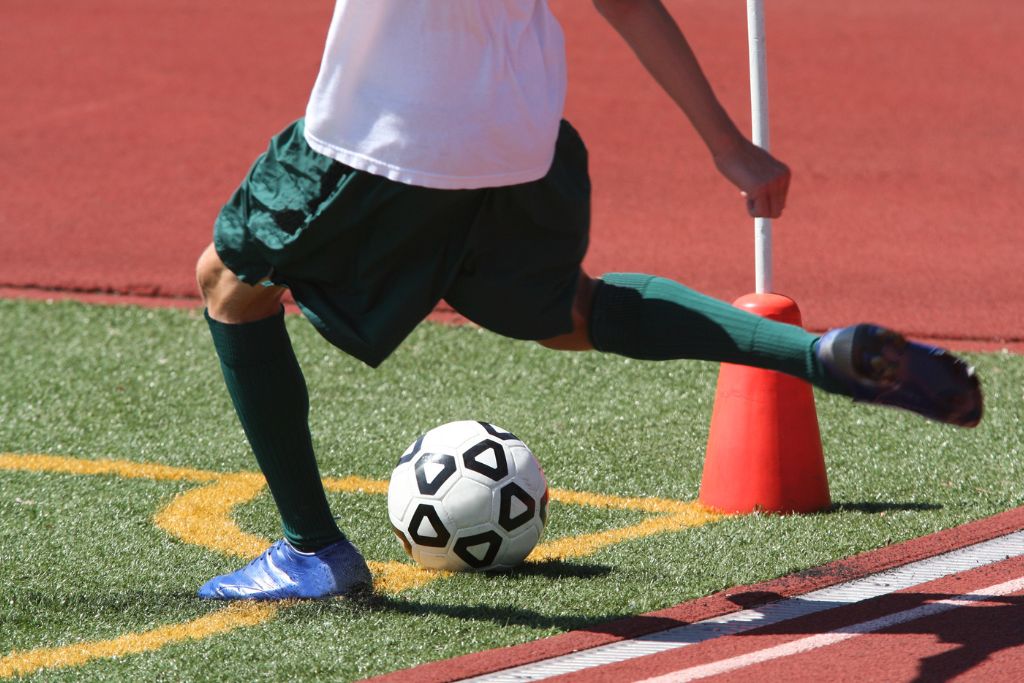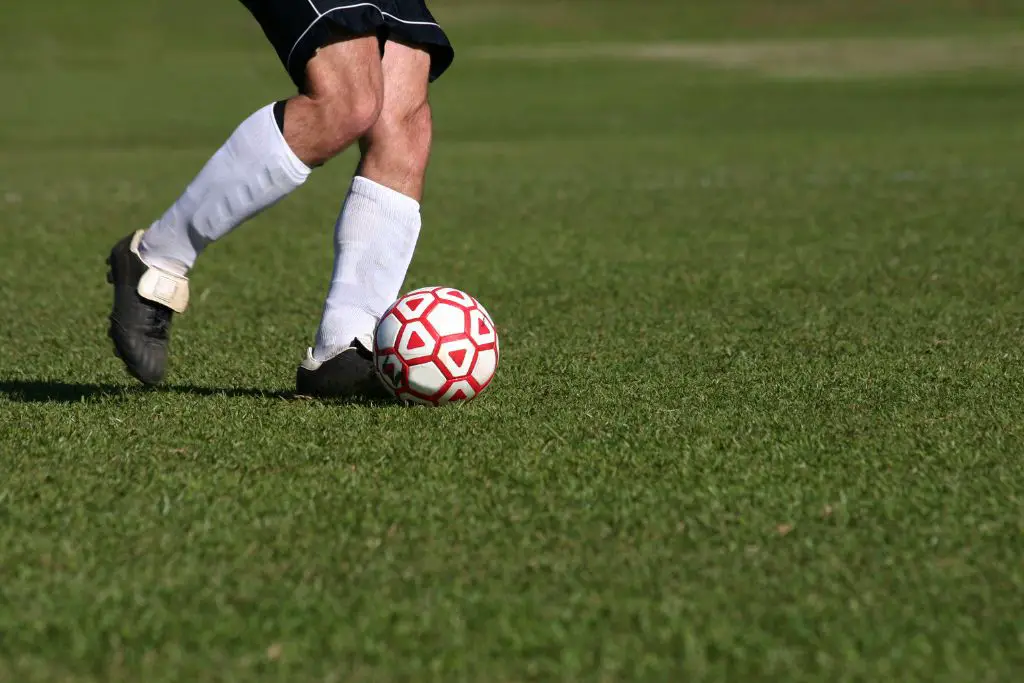When you play soccer and shoot as often as you can in practice, you’re bound to get better. But things can become challenging once the game starts and opponents are on the field. Defenders might pressure you, or your teammates might not give you enough space for a clear shot.
Shooting in soccer requires tons of practice and dedication. While it’s easier to shoot from specific locations on the pitch, such as outside the 18-yard (16.5-m) box, you can always improve your shooting skills and learn how to shoot from several other positions.
With that in mind, keep reading for more information about shooting in soccer and take your game to the next level. This guide has been tailored to help beginners learn how to shoot professionally.
What Part of Foot Is Used To Kick a Soccer Ball?

Kicking a soccer ball takes a lot of power and precision, so it’s essential to know which part of your foot you should use. If you kick with the wrong part of your foot, you could hurt yourself and even miss the target completely.
You can use any part of your foot to kick a soccer ball. However, the best part of the foot to use is the inside of your foot. The inside of your foot is the area inside the arch. The outer part of your foot is not always recommended since it’s harder to control the ball’s direction.
With power shots, your ankle, tarsals, metatarsals, and phalanges will be the most active parts of the foot. Regardless, you must keep your foot firm when taking the shot. Anything less may lead to injury when your foot absorbs the impact of colliding with the ball.
Do You Kick a Soccer Ball With Your Toe?

Most people are used to kicking with their instep, which is almost always instinctive. However, putting your toe on the ball is not always the best option unless you’re going for speed.
You can kick a soccer ball with your toe, but it is not recommended. While the toes are important, they are prone to injury when subjected to hard impact with a soccer ball. Besides, toes deprive your shot of the accuracy it needs.
This is not to say that making a clean shot with your toes is impossible. In fact, some players have mastered how to do this in a technique called the “toe-poke” or “toe-punt.” In this technique, the player hits the ball hard and fast with the tip of their toe.
Often, the toe-poke technique majors more on speed than accuracy. When done at precisely the right moment, it may result in a goal for the attacking team.
Do You Kick a Soccer Ball With the Inside of Your Foot?
The inside foot is probably the most important part of the foot for a wide variety of passing, dribbling, and shooting techniques.
You can kick a soccer ball with the inside of your foot when passing the ball to your teammates, shooting, or curling the ball away from the opponent’s goalkeeper. However, kicking inside your foot may not always produce the most accurate or powerful shots.
Here’s a video of a simple inside foot technique to put things into perspective:
The inside foot technique is relatively simple to do. It involves just these few steps:
- Place your standing foot (usually the left foot for a right-handed person) about 10 inches (25.4 cm) from the ball, pointing in the direction you want it to go.
- Lock your ankle to keep your feet and muscles firm. This will give you an accurate and powerful shot.
- Kick the middle of the ball with the inside of your right foot
- Your standing foot should face straight ahead while the kicking foot is facing sidewards.
As you can see, it’s difficult to get some power behind the shot with the inside of your foot. Players use this technique for close-range finishes, spectacular finesses, and ordinary passes.
Proper Technique of Kicking a Soccer Ball

If you’re just getting started in soccer, you’ll want to ensure you have the proper technique for kicking a soccer ball. While there are many ways to kick a ball, the most effective way is one that’s comfortable for you. For instance, some newer players lack the right form, often leading to countless hours of frustration.
That being said, here’s the proper technique for kicking a soccer ball:
Stay Alert!
Watch other players and their movements. Look out for your striker’s run and opponent’s movements. This will help you determine whether it’s better to pass on the ball or just shoot into the opponent’s goalpost.
Lock Your Ankle
Keeping your ankle locked prevents accidental injury when the ball comes into contact with your foot. Push your toes slightly upwards to lock the ankle and make it firmer for the hard impact. A locked ankle transfers most of the force to the ball, while a loose ankle absorbs most of the impact.
Positioning and Body Posture
The position and posture of the body are important. Here are a few points to remember:
- Keep your body relaxed when kicking the ball. Your standing foot should be a few inches from the ball. Maintain a firm grip on the ground, and don’t lean too much. Also, always ensure that you’re facing the direction you want the ball to go.
- To get a powerful shot, draw the kicking leg back but not too far. Drawing your leg too far may make you lose balance.
- The rest of the body positions itself naturally when you master how to kick. All you need now is a constant practice to perfect your new skill.
For even more power, pivot your foot and use the instep area, which is the top part of your foot that’s right above your toes. Strike the ball hard at its center while aiming at your target.
How To Kick a Soccer Ball in the Air
When the ball is in the air, you have the opportunity to get creative with your shots. You can try to hit the ball towards the goal in an attempt to score, pass the ball over to your teammates, or try to chip the ball over the other team’s player.
Here’s how to kick the ball in the air:
- Take 2-3 steps back and approach the ball at a bent angle.
- Your feet should be facing the right side of the target.
- Plant your left foot a couple of inches to the ball.
- Scoop the ball by striking the lower part of the ball, not directly below it.
Avoid scooping the ball from the sides. Leaning your body backward puts some power and curves behind the ball. If you want to kick the ball higher, all you have to do is take a few steps back and add some power to your kick by drawing your striking foot a little further.
Here’s a video that shows how to kick a ball higher and farther:
Where Should I Look When Shooting a Soccer Ball?
You should always look in the direction you want the ball to go towards. If you’re shooting the ball towards the goal or you’re trying to pass the ball to one of your teammates, you want to make sure you look at your teammate.
In soccer, the ball may not always go in your desired direction. As a general rule, you should always look where you’re shooting. At the same time, you want to keep your eyes focused on the ball and pick your spot.
What Part of the Ball Should You Aim for While Kicking a Shot?
Did you know that where you actually hit the soccer ball determines the velocity and direction of the ball? For example, as mentioned earlier, scooping the ball from the bottom kicks it up, and how much force you put in this part determines how far the ball flies.
You should always aim for the center of the soccer ball while kicking a shot. Striking the ball in the middle transfers more force to the ball in the direction of the target. If you want to add height to the ball, hit it below the middle.
How To Kick a Soccer Ball Without Hurting Your Foot
If you play soccer for long, you will notice that after continuous use of your left or right foot, that specific part of your foot starts hurting. Players do get injuries of varying intensities on the tibia, fibula, and ankle bone, resulting from using the wrong technique, bad landing, and hitting the ball with the wrong part of the foot.
Laces
Here, the player shoots the ball with the top part of the foot
- Line up a few steps behind the ball.
- Build up to the ball and plant your support foot a couple of inches to the side of the ball.
- Lock your ankle and hit the middle part of the ball hard with the part of the foot just above the big toe.
- Land on your kicking foot.
The video below explains the laces technique in detail:
Final Thoughts
There you have it, a complete guide to help you master the basic soccer kicking skills. Keep in mind that if you want to shoot like a pro, you need to practice consistently like a pro. That means getting out on the field and kicking plenty of soccer balls.
Sources
- Quora: What are some techniques when shooting in soccer?
- Active SG: How do you shoot in football?
- YouTube: 4 ESSENTIAL SHOOTING TECHNIQUES EXPLAINED
- YouTube: 5 beginner mistakes to AVOID when shooting
- YouTube: How To Shoot With Power | Shooting Tutorial For Footballers | The Ultimate Guide
- 360 player: The Ultimate Guide To Soccer Shooting – Tips & Drills To Master Proper Technique
- Wiki How: how to kick a soccer ball
- Soccer coaching pro: How to Kick a Soccer Ball Perfectly (10-Step Guide)
- Wiki How: How to Chip a Soccer Ball
